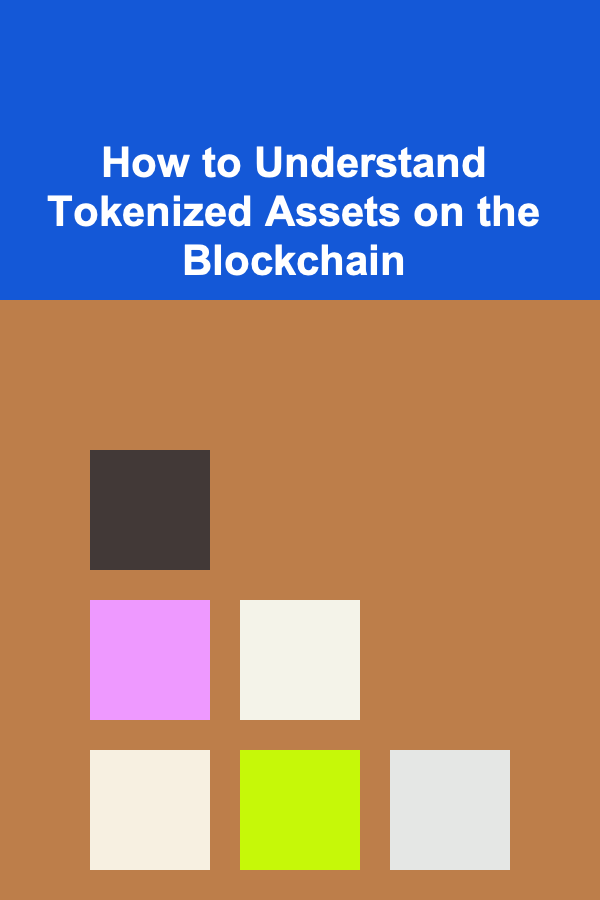
How to Understand Tokenized Assets on the Blockchain
ebook include PDF & Audio bundle (Micro Guide)
$12.99$10.99
Limited Time Offer! Order within the next:

The advent of blockchain technology has revolutionized various industries, bringing forth new concepts and opportunities for digital asset management. One of the most transformative developments in recent years is the creation of tokenized assets. Tokenized assets allow for the representation of real-world assets in a digital form, enabling broader access and increasing efficiency in transactions. This article will explore tokenized assets on the blockchain, covering their definition, the technology behind them, the benefits and challenges of tokenization, and how tokenized assets are changing the landscape of finance, real estate, art, and more.
What are Tokenized Assets?
At its core, a tokenized asset is a digital representation of a real-world asset on a blockchain. These assets are represented by a token, which is a unit of value issued on a blockchain network. Tokenization involves converting the ownership rights of physical assets, such as real estate, art, commodities, or even intellectual property, into digital tokens that can be easily traded or transferred on the blockchain.
For instance, instead of directly selling a piece of real estate, an owner could tokenize the property, issuing digital tokens that represent fractional ownership. These tokens can then be bought or sold on a blockchain-based exchange, allowing investors to own a share of the property without physically purchasing it.
Tokenization leverages blockchain technology's inherent features, such as decentralization, immutability, and transparency, to offer more efficient ways of transferring ownership and accessing assets. The tokens can be easily transferred between parties without the need for intermediaries, such as banks, brokers, or other financial institutions.
The Technology Behind Tokenization
Blockchain
Blockchain technology is the backbone of tokenized assets. A blockchain is a distributed ledger that records transactions in a secure and transparent manner. It ensures that once a transaction is recorded, it cannot be altered or deleted. This immutability is a key feature for tokenized assets, as it guarantees the authenticity of asset ownership.
When an asset is tokenized, its ownership details are recorded on a blockchain. This means that every transfer or transaction involving the tokenized asset is visible to all participants on the network, adding transparency to the process.
Blockchain provides the foundation for creating, transferring, and trading tokenized assets. Platforms such as Ethereum, Binance Smart Chain, and others enable the creation of smart contracts that automate the issuance and transfer of tokens. These smart contracts are self-executing contracts with the terms of the agreement directly written into code, ensuring that the conditions for transferring ownership are met before a transaction is processed.
Tokens and Smart Contracts
Tokens are digital representations of assets, and they exist on the blockchain as unique entities. Tokens can represent anything from equity in a company to a physical object like real estate or a commodity. The most common types of tokens include:
- Security Tokens: These tokens represent ownership of an asset, such as a share of a company, or a real estate investment. Security tokens are often subject to regulatory oversight because they represent financial interests and can be traded as securities.
- Utility Tokens: These tokens grant access to a specific service or product within a platform or ecosystem. They are often used to facilitate transactions within decentralized applications (dApps) or blockchain-based platforms.
- Non-Fungible Tokens (NFTs): NFTs represent unique assets, such as digital art, collectibles, or rare items. Unlike other tokens, NFTs cannot be exchanged on a one-to-one basis because each token has its unique value and properties.
Smart contracts play a crucial role in tokenization. These contracts automatically execute actions based on pre-set conditions. For example, a smart contract for a tokenized property might automatically transfer ownership of the property tokens once the buyer has paid the required amount in cryptocurrency. This automation eliminates the need for intermediaries, streamlining the process and reducing costs.
How Tokenized Assets Work
Tokenized assets work by creating a digital token that represents ownership rights of a physical asset. Here's an overview of how tokenized assets typically function:
Step 1: Asset Identification and Valuation
Before tokenization can take place, the asset being tokenized must be identified and valued. This step involves determining the asset's worth and understanding how it can be divided into shares or tokens. For example, a piece of real estate may be valued based on its market price and location, while a piece of art may be valued based on its rarity and historical significance.
Step 2: Creating the Token
Once the asset has been identified and valued, a smart contract is created on a blockchain to represent the asset. The smart contract outlines the terms of ownership, such as the number of tokens to be issued, the ownership rights associated with the tokens, and how transactions will be conducted.
For example, a real estate asset may be tokenized by issuing 1000 tokens, where each token represents 0.1% ownership in the property. The smart contract will ensure that these tokens can be traded or transferred on the blockchain according to the predefined terms.
Step 3: Issuance and Distribution
After the smart contract is deployed, the tokens are issued to the asset owner, investors, or participants in the token sale. Tokens can be distributed to users through a variety of methods, including token sales, auctions, or airdrops. The token holders now have legal ownership rights to the asset as represented by their tokens.
Step 4: Trading and Transfer
Once the tokens are issued, they can be freely traded on blockchain-based exchanges or peer-to-peer platforms. Token holders can buy, sell, or transfer their tokens at any time, with transactions recorded on the blockchain. This allows for more liquid and efficient markets for traditionally illiquid assets, such as real estate or art.
In the case of security tokens, trading may be subject to regulations depending on the jurisdiction. However, the process of transferring tokens remains faster and more efficient compared to traditional methods, as it doesn't require third-party intermediaries.
Step 5: Redemption and Asset Management
Tokenized assets can be redeemed or liquidated in various ways. In the case of real estate, for example, token holders may receive dividends from rental income or may be able to sell their tokens in a secondary market. Similarly, for tokenized commodities, holders may receive a share of the commodity's profits.
For the underlying asset, tokenization also offers opportunities for easier management, as blockchain technology provides a secure, transparent, and immutable record of all transactions and ownership transfers.
Benefits of Tokenized Assets
Tokenized assets offer numerous advantages over traditional forms of asset ownership and transfer. Some of the most notable benefits include:
1. Increased Liquidity
Tokenized assets provide increased liquidity by enabling fractional ownership. For example, instead of having to buy an entire property, investors can buy a fraction of it through tokens. This opens up the market to a broader group of investors, including smaller investors who might not have had access to high-value assets before.
2. Access to Global Markets
Blockchain's decentralized nature enables tokenized assets to be traded globally without geographic limitations. Investors from around the world can participate in the market, broadening the pool of potential buyers and sellers.
3. Reduced Costs
Tokenization eliminates the need for intermediaries such as banks, brokers, and other financial institutions, reducing transaction costs. Moreover, the use of smart contracts automates many processes, reducing administrative overhead and improving efficiency.
4. Transparency and Security
Since token transactions are recorded on a blockchain, all parties involved have access to a transparent, immutable record of ownership and transfer. This increases trust in the system and reduces the risk of fraud or disputes. Blockchain's security features, such as encryption and decentralized consensus mechanisms, also enhance the safety of tokenized assets.
5. Fractional Ownership
Tokenization allows for fractional ownership, enabling investors to own a small portion of an asset without needing to purchase the entire asset. This lowers the barrier to entry for investors and allows for diversification of portfolios.
6. Faster Transactions
Tokenized assets can be transferred and settled much faster than traditional asset transactions. Blockchain transactions can occur in minutes, whereas traditional asset transfers may take days or even weeks due to the involvement of intermediaries and paperwork.
Challenges of Tokenized Assets
Despite the many advantages, tokenized assets face several challenges that need to be addressed before they can reach their full potential:
1. Regulatory Uncertainty
One of the biggest challenges for tokenized assets is the lack of clear regulatory frameworks in many jurisdictions. Security tokens, in particular, are often subject to complex regulations, and navigating these legal requirements can be difficult for both issuers and investors.
2. Market Adoption
Tokenized assets are still relatively new, and the market for them is not yet fully mature. Widespread adoption will require building trust, educating potential investors, and ensuring that platforms for buying, selling, and trading tokenized assets are user-friendly and secure.
3. Technical Challenges
Blockchain technology, while revolutionary, is still evolving. Issues such as scalability, interoperability between different blockchain networks, and network congestion need to be addressed for tokenized assets to function smoothly at scale.
4. Valuation and Pricing
The process of valuing tokenized assets can be complex, particularly for unique or illiquid assets. Without clear pricing models, it can be difficult to establish fair market value for tokenized assets, potentially leading to price volatility.
5. Security Risks
While blockchain itself is secure, the platforms that issue and trade tokenized assets can be vulnerable to cyberattacks. Ensuring the security of digital wallets, exchanges, and smart contracts is critical to the success of tokenized assets.
The Future of Tokenized Assets
As blockchain technology continues to mature, tokenized assets are expected to play a central role in the future of finance, real estate, art, and beyond. The ability to fractionalize assets, increase liquidity, and offer global access to investment opportunities makes tokenization a promising solution to many of the inefficiencies in traditional financial markets.
However, regulatory clarity, market adoption, and technological advancements will be key to realizing the full potential of tokenized assets. As these challenges are addressed, tokenization could fundamentally reshape how we own, trade, and invest in assets.
Conclusion
Tokenized assets are a powerful innovation that bridges the gap between the physical and digital worlds. By using blockchain technology to represent real-world assets as digital tokens, tokenization offers benefits such as increased liquidity, reduced costs, greater transparency, and enhanced security. However, challenges related to regulation, adoption, and technology must be overcome for tokenized assets to realize their full potential.
As the blockchain ecosystem evolves, tokenization is set to play a pivotal role in transforming industries ranging from finance to real estate, art, and beyond. Understanding tokenized assets is crucial for anyone looking to navigate the future of digital finance and investment.
Reading More From Our Other Websites
- [Organization Tip 101] How to Set Realistic Financial Goals for the Year
- [Organization Tip 101] How to Organize Clothes by Season for Easy Access
- [Personal Care Tips 101] How to Find a Toothbrush That Helps with Your Oral Hygiene Goals
- [Organization Tip 101] How to Set a Realistic Budget for Your Event
- [Simple Life Tip 101] Best Minimalist Kitchen Hacks for Small Urban Apartments
- [Personal Care Tips 101] How to Choose the Best Hair Dry Shampoo for Your Hair Type
- [Home Space Saving 101] How to Create a Small Home Gym Without Cluttering
- [Home Cleaning 101] How to Remove Odors from Home by Incorporating Smart Cleaning Tools and Gadgets
- [Small Business 101] Best Business Loans for Small Businesses: Comparing Your Options
- [Gardening 101] 5 Common Mistakes When Drying Herbs (And How to Avoid Them)

How to Clean Your Refrigerator and Keep It Odor-Free
Read More
How to Create a Budget-Friendly Gallery Wall
Read More
How to Use Vertical Storage to Save Space in Your Home
Read More
How To Understand the Basics of Black Holes
Read More
How To Apply Highlighter for a Subtle Glow
Read More
How to Create a Self-Care Checklist for Busy Moms
Read MoreOther Products

How to Clean Your Refrigerator and Keep It Odor-Free
Read More
How to Create a Budget-Friendly Gallery Wall
Read More
How to Use Vertical Storage to Save Space in Your Home
Read More
How To Understand the Basics of Black Holes
Read More
How To Apply Highlighter for a Subtle Glow
Read More